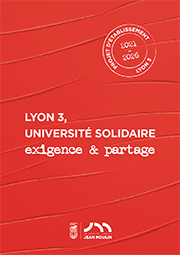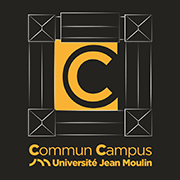AccueilRechercheProgrammes et productions scientifiquesThèsesThèses soutenuesThèses soutenues - 2006-2021Thèses soutenues - 2016
-
Partager cette page
- Recherche,
AIT HAMOU Sarah
L’arabisation, enjeu multidimensionnel du pouvoir en Algérie : l’exemple du système éducatif de 1962 à 2000
Publié le 5 juillet 2016 – Mis à jour le 14 décembre 2018
Thèse en Science politique soutenue le 10 juin 2016.
La politique d’arabisation commune aux trois pays du Maghreb, le Maroc, la Tunisie et l’Algérie, a été beaucoup plus problématique dans ce dernier pays. En effet, le cas algérien attire particulièrement l’attention dans la mesure où l’équation linguistique, plus précisément sociolinguistique, ne semble toujours pas résolue aujourd’hui. Effectivement, les récentes évolutions en matière linguistique à l’exemple de la reconnaissance de la langue berbère, Tamazight, comme langue officielle montrent que la question linguistique est loin d’être un acquis, mais aussi et surtout que celle-ci est très liée au pouvoir politique. C’est dans ce cadre précis que nous avons choisi d’appréhender la politique d’arabisation algérienne de 1962 à 2000 en tant qu’enjeu multidimensionnel, avec pour exemple l’arabisation du système éducatif algérien afin d’en mesurer les résultats et conséquences sur l’ensemble du système algérien, aussi bien politique, social et économique qu’idéologique, linguistique et culturel.
Cette thèse s’articule autour de deux grandes parties, chacune d’entre elles étant divisée en deux chapitres. La première partie pose les jalons de la construction de l’Etat algérien, à travers une rétrospective historique allant de l’Algérie précoloniale à l’Algérie postcoloniale. Dans cette partie, deux chapitres sont abordés, le premier portant sur la genèse du système politique algérien à travers lequel sont mis en évidence les principes et fondements de l’Etat algérien et sa formation nationale ; et le second est consacré à la construction identitaire algérienne autour de la politique d’arabisation et particulièrement de la généralisation de l’utilisation de la langue arabe, et dans lequel a été questionné le rapport entre politique d’arabisation et édification nationale et identitaire.
D’autre part, dans une deuxième partie traitant des usages politiques de l’arabisation en Algérie, un premier chapitre empirique a été traité afin d’appréhender la politique d’arabisation de fa?on plus concrète et pragmatique, notamment à travers son application dans l’enseignement algérien ; et enfin dans un second et dernier chapitre, c’est la politique d’arabisation au coeur du pouvoir algérien et la mise en exergue des dynamiques, des enjeux et des luttes de pouvoir que cette politique a fait na?tre qui ont été mis en avant.
Dans cette perspective, nous nous sommes interrogés sur le r?le et la fonction de la politique d’arabisation dans la construction nationale et étatique algérienne, et plus globalement dans l’édification du système politique algérien aux caractéristiques spécifiques. En d’autres termes, il s’agit de déconstruire les liens entre une politique dite linguistique et le pouvoir qui l’a mise en place en retra?ant l’évolution historique de la politique d’arabisation algérienne depuis l’indépendance du pays en 1962 jusqu’en 2000, soit un an après l’arrivée de l’actuel Président Abdelaziz Bouteflika au pouvoir. L’on verra ainsi comment la politique d’arabisation est présentée d’abord comme une politique linguistique, puis comme une politique identitaire et idéologique pour enfin se révéler être une politique de pouvoir et véritable enjeu de luttes au entre les différentes factions au pouvoir.
Ainsi, d’un point de vue strictement théorique, nous avons d’abord présenté une approche constructiviste, de construction nationale mais aussi identitaire, en nous appuyant sur des théoriciens tels qu’Anthony D. Smith, Ernest Gellner, Benedict Anderson, Adrian Hastings, Juan Linz et Mohammed Darviche. Ainsi, l’apport théorique concernant la nation algérienne, de sa préexistence à sa construction, sera principalement basée sur les travaux de spécialistes de la nation tels que E. Gellner pour qui, il n’existe pas de nationalisme là où il n’y pas d’Etat, et à cette vision est opposée celle de E. Renan pour qui les principes de volonté et de plébiscite suffisent à l’émergence d’une nation.
De même, dans le cadre de la construction idéologique, celle de l’arabo-islamisme notamment (des liens entre langue et religion), et de sa corrélation avec la politique d’arabisation algérienne, nous nous sommes appuyés sur les définitions des spécialistes de l’idéologie tels que Pierre Ansart.
Du point de vue idéologique, la politique d’arabisation relève clairement de l’idéologie arabo-musulmane dans laquelle s’inscrit explicitement l’aile conservatrice du parti unique FLN qui l’a instaurée. L’orientation idéologique arabo-musulmane se dessine dès l’apparition du nationalisme algérien et en particulier avec le nationalisme religieux des Oulémas. A partir de là, nous avons questionné le rapport de la politique d’arabisation à l’idéologie arabo-musulmane.
Du point de vue identitaire, la politique d’arabisation a été utilisée dans plusieurs discours politiques à travers une rhétorique identitaire dont les objectifs sont la garantie de la cohésion et de l’unité nationales parfois menacées par les revendications linguistiques et culturelles de la minorité berbère.
Du point de vue linguistique et culturel, ce sont les processus de déclassement de la langue arabe, de déculturation et de dépersonnalisation de l’individu algérien par la politique coloniale fran?aise qui donne le point de départ d’une politique d’arabisation que d’aucuns considèrent comme étant in fine une politique de réarabisation. Il s’agit donc davantage d’une arabisation de l’administration et des institutions du pays que de la population considérée comme étant anthropologiquement arabe et/ou arabo-berbère, est c’est en cela que le problème se pose. Ce sont donc tous ces éléments, politiques, idéologiques et identitaires qui donnent naissance à la mise en place d’une succession importante de lois d’arabisations. Parmi elles, la principale est la loi n°91-05 portant généralisation de l’utilisation de la langue arabe qui a connu de nombreux bouleversements et n’a finalement jamais été véritablement appliquée. Tout cela montre à quel point, la politique d’arabisation a été un processus lent, discontinu, parfois fragile, mais surtout qu’elle a été davantage au coeur de luttes de pouvoir, en servant ce dernier qu’une politique linguistique à proprement parler servant la langue arabe et la population qui la parle.
En effet, la politique d’arabisation telle que mise en place par les différents pouvoirs successifs, et particulièrement par le régime du président H. Boumediene, est directement émise par le FLN, le parti révolutionnaire algérien de 1954 à 1962, érigé en parti unique dans l’Algérie indépendante jusqu’à l’ouverture démocratique de 1989. A partir de ce moment-là, on assiste à l’apparition d’une multitude d’associations et partis politiques aboutissant à une crise de régime en 1991 où l’armée intervient pour mettre fin au processus électoral et les premières élections libres du pays, afin d’empêcher les islamistes du FIS (Front islamique du Salut) d’accéder au pouvoir.
L’apparition de ces nouveaux acteurs sur la scène politique, aussi bien les islamistes du FIS et plus tard, après dissolution du FIS par le pouvoir algérien, ceux du MSP (Mouvement de la société pour la paix), que les berbéristes et démocrates du FFS (Front des Forces socialistes parti clandestin existant depuis 1963 et reconnu dès 1989 avec l’ouverture au pluripartisme) et du RCD (Rassemblement pour la culture et la démocratie), placent la politique d’arabisation dans une nouvelle dynamique de pouvoir. Ainsi, tandis que durant la période du parti unique qui l’a instaurée, elle était incontestée et incontestable, la politique d’arabisation devient contestable et de plus en plus remise en cause. Elle est ainsi au coeur d’une véritable lutte de pouvoirs, tant?t revendiquée par quelques-uns, tant?t instrumentalisée par certains, et tant?t dénoncée par d’autres. Tout cela a conduit à montrer qu’au-delà des dimensions idéologique,
identitaire, et linguistique attribuées à l’arabisation, la dimension prépondérante est bien celle d’enjeu et de stratégie de pouvoir.
Tout l’enjeu a été de retracer socio-historiquement le processus d’arabisation pour en arriver à la conclusion de la dimension ultra-politique de celle-ci, une dimension qui prend le dessus sur toutes les autres composantes de la politique d’arabisation et qui, in fine, a servi un objectif primordial du régime algérien, celle de la pérennisation de son système politique, fragile et illégitime ,basé sur un exécutif au faible pouvoir et une armée véritable détentrice du pouvoir.
Enfin, c’est l’exemple empirique du système éducatif algérien et de l’arabisation dont il a été l’objet, que nous avons remis en question afin de savoir s’il y a relation entre la politique d’arabisation et les dysfonctionnements et failles scolaires que l’on peut noter dans les diverses données chiffrées auxquelles nous avons eu accès. La principale question a été celle de se demander si l’école algérienne, en tant que facteur de développement économique et social, à travers l’arabisation qui lui a été imposée, est à l’origine de l’échec scolaire algérien. Pour cela nous avons d? prendre en compte plusieurs paramètres dont l’Ecole fondamentale, système particulier d’école, comme outil de compréhension.
The arabization policy is a common policy to the three countries of Maghreb, Morocco, Tunisia and Algeria. However, it has been more problematical in Algeria than in the two other countries. Actuallly, the algerian case is interesting to study because of the fact that the linguistic equation is still challenging and remain unresolved. The latests evolutions in the linguistic field, as the example of the recognition of the berber language, Tamazight, as an official language, show that this topic cannot be considered as an acquis, and above all that it’s an issue that is very much tied to political power. In that context, we choose to discuss the arabization policy from 1962 to 2000 as a multidimensionnal issue, with the example of the educational system in order to give a more valid measure of its impact on the algerian system as a whole, the political, social and economic system as well as the ideological, linguistic and cultural one.
This thesis is structured around two parts, each of them is subdivided into two chapters. The purpose of the first part is to establish the foundations of the construction of the algerian state, through an historical retrospective from the pre-colonial period to the post-colonial one. In this part, two chapters are submited. The first one deals with the algerian political system’s genesis
into which the principles and foundations of the algerian state and its national formation ; the second chapter focuses on the algerian identity building around the arabization policy and especially the generalization of the utilization of the arabic language, it questions the link between arabizaion policy and national and identitary building.
On the other hand, the second part is about the political purposes of the arabization policy in Algeria in which the first chapter is empirical in order to get a clear understanding of the pratical side of the arabization policy, particularly in the educational system ; and finally the second and last chapter, it’s about arabization and power, it comes to include arabization policy in the heart of the algerian power and to point out the dynamics, the issues, concerns and struggles that are involved by such a policy.
When we look at that perspective, we have questioned the role and function of the arabization policy in the algerian state and national building, and more generally in the edification of the algerian system and its particular characteristics. In other words, it is about deconstructing the links between a policy known as linguistic and the power that established it, by tracing the historical evolution of the arabization policy since Algeria’s independance in 1962 to 2000, one year after the present President Abdelaziz Bouteflika came to power. Thus, we have seen, how the arabization policy has been first presented as a linguistic policy, then as an identity policy and finally has proven to be a power policy and a real power game and struggle.
In this way, from a strict theorical point of you, we first presented a constructivist approach, of a national building and identity building, by using theorists’ references such as those of Anthony D.Smith, Ernest Gellner, Benedict Anderson, Adrian Hastings, Juan Linz and Mohammed Darviche. Thus, the theorical contribution about algerian nation, from its preexistence to its building, will be based mainly on research studies of specialists such as E. Gellner to whom there is no nationalism where there is no state, unlike E. Renan’s vision which considers that political will and plebiscite principles are enough to the emergence of a nation.
As well, in the context of ideological construct, particularly related to arab-islamic one (links between language and religion), and its correlation between algerian arabization policy, we refered to experts of ideology such as Pierre Ansart.
From an ideological point of view, arabization policy goes to arab-islamic ideology into which explicitly fit the conservative faction of the single party FLN (Front for National Liberation) which initiated it. The arab-muslim orientation is begining to dawn at the first sign of algerian
nationalism, and especially the Oulemas’ religious nationalism in the early 1920s. From there, the relation between arabization policy and arab-muslim ideology has been questioned.
In terms of identity, arabization policy has been used in many political speeches, through a rhetorical identity whose goals are guaranteeing of national cohesion and national unity which are sometiemes threatened by linguistic and cultural claims of the berber minority.
From a linguistic and cultural point of view, the processes of downgrading of the arabic language, and the acculturation and depersonalisation of the algerian individual by the french colonial policy are the starting point of an arabization policy which some consider like a rearabization policy. It is therefore more an arabization of administration and institutions than the arabization of population which is considered as already being arabic. All these facts, political, ideological and identity ones set up a series of arabization laws.
Amongst them, the main one is the law n°91-05 on the generalization of the utilization of the arabic language which has experienced difficulties and finally will not be really applied. All of this point out how much arabization policy has been a very long process, discontinuous, and fragile. But especially, we have proved that arabization policy has been more a power issue serving the algerian political regime than a linguistic policy serving arabic language and population.
Actually, the arabization policy which is put in place, particularly by the government of the President Houari Boumediene, came from the single party FLN, the revolutionary party 1954-1962. It remains the single party until 1989, during the democratic opening to multiparty system. From there, we’re witnessing the emergence of a multitude of associations and political parties leading to a regime crisis where the army had to intervene to put an end to the electoral process in order to stop the FIS party (The Islamic Salvation Front) to access to political power.The emergence of these new actors on the political stage, both the islamists of FIS and a few years later, after FIS party’s dissolution, those of MSP party (Movement of Society for Peace), as well as the Berberists and Democrats from FFS (Socialist Forces Front) and RCD (Rally for Culture and Democracy) place the arabization policy in a new power dynamics.
Thus, whereas during the single party system, the arabization policy was uncontested and undeniable, it becames contestable and questionable. It is set up in the heart of power issues and struggles, sometimes claimed by some political protagonists, sometimes exploited by others, and sometimes denounced. All this lead to figure out that beyond the ideological,
identity and linguistic dimension of arabization, the major dimension is that of power issue and strategy.
In fact, the issue was to retrace the socio-historic arabization process in order to conclude that it’s definitely defined by the ultra-political dimension of the arabization, a dimension which is the most typical and the most representative of the arabization policy and which, ultimately, has served an essential purpose of the algerian regime, that of the sustainability of the political system of the illegitimate, fragile regime which is based on a weak executive power and an army which is the real detaining power.
Lastly, it’s the empiric example of the educational system after arabization that was interesting to clarify, and to question the eventual relation between arabization policy and the scholastic dysfunctions observed through the comparable figures that has been collected. The main question was to know if the algerian school, as a social and economic development factor, through the arabization policy, is the reason of the educational failure. For this purpose, we had to take the specifity of fundamental school into consideration.
Mots-Clés : Arabisation, politique linguistique, identité nationale, stratégie de pouvoir, idéologie, pouvoir idéologique, cohésion nationale, unité nationale, langue arabe, langue berbère, école fondamentale, système éducatif algérien, dysfonctionnement du système éducatif algérien.
Keywords : Arabization, linguistic policy, identity national, power strategy, ideology, ideological power, national cohesion, national unity, Arabic language, Berber language, fundamental school, algerian educational system, Algerian eduacational system’s dysfunctions.
Directrice de thèse : Brigitte VASSORT-ROUSSET
Membres du jury :
- WALTER Stéphane Ma?tre de conférences HDR Université du Havre
- SAYAH Jamil Ma?tre de conférences HDR Université de Grenoble
- LAHOUARI Addi Professeur des universités Institut d’Etudes politiques de Lyon
- BOURGOU Taoufik Ma?tre de conférences HDR Université Jean Moulin Lyon 3
- SAHLOUL Henri Hassan Professeur des universités Université Jean Moulin Lyon 3
- VASSORT-ROUSSET Brigitte Professeur des universités Université Jean Moulin Lyon 3
Président du jury : Addi LAHOUARI
Mention : Très honorable
Equipe d'accueil : Francophonie
Cette thèse s’articule autour de deux grandes parties, chacune d’entre elles étant divisée en deux chapitres. La première partie pose les jalons de la construction de l’Etat algérien, à travers une rétrospective historique allant de l’Algérie précoloniale à l’Algérie postcoloniale. Dans cette partie, deux chapitres sont abordés, le premier portant sur la genèse du système politique algérien à travers lequel sont mis en évidence les principes et fondements de l’Etat algérien et sa formation nationale ; et le second est consacré à la construction identitaire algérienne autour de la politique d’arabisation et particulièrement de la généralisation de l’utilisation de la langue arabe, et dans lequel a été questionné le rapport entre politique d’arabisation et édification nationale et identitaire.
D’autre part, dans une deuxième partie traitant des usages politiques de l’arabisation en Algérie, un premier chapitre empirique a été traité afin d’appréhender la politique d’arabisation de fa?on plus concrète et pragmatique, notamment à travers son application dans l’enseignement algérien ; et enfin dans un second et dernier chapitre, c’est la politique d’arabisation au coeur du pouvoir algérien et la mise en exergue des dynamiques, des enjeux et des luttes de pouvoir que cette politique a fait na?tre qui ont été mis en avant.
Dans cette perspective, nous nous sommes interrogés sur le r?le et la fonction de la politique d’arabisation dans la construction nationale et étatique algérienne, et plus globalement dans l’édification du système politique algérien aux caractéristiques spécifiques. En d’autres termes, il s’agit de déconstruire les liens entre une politique dite linguistique et le pouvoir qui l’a mise en place en retra?ant l’évolution historique de la politique d’arabisation algérienne depuis l’indépendance du pays en 1962 jusqu’en 2000, soit un an après l’arrivée de l’actuel Président Abdelaziz Bouteflika au pouvoir. L’on verra ainsi comment la politique d’arabisation est présentée d’abord comme une politique linguistique, puis comme une politique identitaire et idéologique pour enfin se révéler être une politique de pouvoir et véritable enjeu de luttes au entre les différentes factions au pouvoir.
Ainsi, d’un point de vue strictement théorique, nous avons d’abord présenté une approche constructiviste, de construction nationale mais aussi identitaire, en nous appuyant sur des théoriciens tels qu’Anthony D. Smith, Ernest Gellner, Benedict Anderson, Adrian Hastings, Juan Linz et Mohammed Darviche. Ainsi, l’apport théorique concernant la nation algérienne, de sa préexistence à sa construction, sera principalement basée sur les travaux de spécialistes de la nation tels que E. Gellner pour qui, il n’existe pas de nationalisme là où il n’y pas d’Etat, et à cette vision est opposée celle de E. Renan pour qui les principes de volonté et de plébiscite suffisent à l’émergence d’une nation.
De même, dans le cadre de la construction idéologique, celle de l’arabo-islamisme notamment (des liens entre langue et religion), et de sa corrélation avec la politique d’arabisation algérienne, nous nous sommes appuyés sur les définitions des spécialistes de l’idéologie tels que Pierre Ansart.
Du point de vue idéologique, la politique d’arabisation relève clairement de l’idéologie arabo-musulmane dans laquelle s’inscrit explicitement l’aile conservatrice du parti unique FLN qui l’a instaurée. L’orientation idéologique arabo-musulmane se dessine dès l’apparition du nationalisme algérien et en particulier avec le nationalisme religieux des Oulémas. A partir de là, nous avons questionné le rapport de la politique d’arabisation à l’idéologie arabo-musulmane.
Du point de vue identitaire, la politique d’arabisation a été utilisée dans plusieurs discours politiques à travers une rhétorique identitaire dont les objectifs sont la garantie de la cohésion et de l’unité nationales parfois menacées par les revendications linguistiques et culturelles de la minorité berbère.
Du point de vue linguistique et culturel, ce sont les processus de déclassement de la langue arabe, de déculturation et de dépersonnalisation de l’individu algérien par la politique coloniale fran?aise qui donne le point de départ d’une politique d’arabisation que d’aucuns considèrent comme étant in fine une politique de réarabisation. Il s’agit donc davantage d’une arabisation de l’administration et des institutions du pays que de la population considérée comme étant anthropologiquement arabe et/ou arabo-berbère, est c’est en cela que le problème se pose. Ce sont donc tous ces éléments, politiques, idéologiques et identitaires qui donnent naissance à la mise en place d’une succession importante de lois d’arabisations. Parmi elles, la principale est la loi n°91-05 portant généralisation de l’utilisation de la langue arabe qui a connu de nombreux bouleversements et n’a finalement jamais été véritablement appliquée. Tout cela montre à quel point, la politique d’arabisation a été un processus lent, discontinu, parfois fragile, mais surtout qu’elle a été davantage au coeur de luttes de pouvoir, en servant ce dernier qu’une politique linguistique à proprement parler servant la langue arabe et la population qui la parle.
En effet, la politique d’arabisation telle que mise en place par les différents pouvoirs successifs, et particulièrement par le régime du président H. Boumediene, est directement émise par le FLN, le parti révolutionnaire algérien de 1954 à 1962, érigé en parti unique dans l’Algérie indépendante jusqu’à l’ouverture démocratique de 1989. A partir de ce moment-là, on assiste à l’apparition d’une multitude d’associations et partis politiques aboutissant à une crise de régime en 1991 où l’armée intervient pour mettre fin au processus électoral et les premières élections libres du pays, afin d’empêcher les islamistes du FIS (Front islamique du Salut) d’accéder au pouvoir.
L’apparition de ces nouveaux acteurs sur la scène politique, aussi bien les islamistes du FIS et plus tard, après dissolution du FIS par le pouvoir algérien, ceux du MSP (Mouvement de la société pour la paix), que les berbéristes et démocrates du FFS (Front des Forces socialistes parti clandestin existant depuis 1963 et reconnu dès 1989 avec l’ouverture au pluripartisme) et du RCD (Rassemblement pour la culture et la démocratie), placent la politique d’arabisation dans une nouvelle dynamique de pouvoir. Ainsi, tandis que durant la période du parti unique qui l’a instaurée, elle était incontestée et incontestable, la politique d’arabisation devient contestable et de plus en plus remise en cause. Elle est ainsi au coeur d’une véritable lutte de pouvoirs, tant?t revendiquée par quelques-uns, tant?t instrumentalisée par certains, et tant?t dénoncée par d’autres. Tout cela a conduit à montrer qu’au-delà des dimensions idéologique,
identitaire, et linguistique attribuées à l’arabisation, la dimension prépondérante est bien celle d’enjeu et de stratégie de pouvoir.
Tout l’enjeu a été de retracer socio-historiquement le processus d’arabisation pour en arriver à la conclusion de la dimension ultra-politique de celle-ci, une dimension qui prend le dessus sur toutes les autres composantes de la politique d’arabisation et qui, in fine, a servi un objectif primordial du régime algérien, celle de la pérennisation de son système politique, fragile et illégitime ,basé sur un exécutif au faible pouvoir et une armée véritable détentrice du pouvoir.
Enfin, c’est l’exemple empirique du système éducatif algérien et de l’arabisation dont il a été l’objet, que nous avons remis en question afin de savoir s’il y a relation entre la politique d’arabisation et les dysfonctionnements et failles scolaires que l’on peut noter dans les diverses données chiffrées auxquelles nous avons eu accès. La principale question a été celle de se demander si l’école algérienne, en tant que facteur de développement économique et social, à travers l’arabisation qui lui a été imposée, est à l’origine de l’échec scolaire algérien. Pour cela nous avons d? prendre en compte plusieurs paramètres dont l’Ecole fondamentale, système particulier d’école, comme outil de compréhension.
The arabization policy is a common policy to the three countries of Maghreb, Morocco, Tunisia and Algeria. However, it has been more problematical in Algeria than in the two other countries. Actuallly, the algerian case is interesting to study because of the fact that the linguistic equation is still challenging and remain unresolved. The latests evolutions in the linguistic field, as the example of the recognition of the berber language, Tamazight, as an official language, show that this topic cannot be considered as an acquis, and above all that it’s an issue that is very much tied to political power. In that context, we choose to discuss the arabization policy from 1962 to 2000 as a multidimensionnal issue, with the example of the educational system in order to give a more valid measure of its impact on the algerian system as a whole, the political, social and economic system as well as the ideological, linguistic and cultural one.
This thesis is structured around two parts, each of them is subdivided into two chapters. The purpose of the first part is to establish the foundations of the construction of the algerian state, through an historical retrospective from the pre-colonial period to the post-colonial one. In this part, two chapters are submited. The first one deals with the algerian political system’s genesis
into which the principles and foundations of the algerian state and its national formation ; the second chapter focuses on the algerian identity building around the arabization policy and especially the generalization of the utilization of the arabic language, it questions the link between arabizaion policy and national and identitary building.
On the other hand, the second part is about the political purposes of the arabization policy in Algeria in which the first chapter is empirical in order to get a clear understanding of the pratical side of the arabization policy, particularly in the educational system ; and finally the second and last chapter, it’s about arabization and power, it comes to include arabization policy in the heart of the algerian power and to point out the dynamics, the issues, concerns and struggles that are involved by such a policy.
When we look at that perspective, we have questioned the role and function of the arabization policy in the algerian state and national building, and more generally in the edification of the algerian system and its particular characteristics. In other words, it is about deconstructing the links between a policy known as linguistic and the power that established it, by tracing the historical evolution of the arabization policy since Algeria’s independance in 1962 to 2000, one year after the present President Abdelaziz Bouteflika came to power. Thus, we have seen, how the arabization policy has been first presented as a linguistic policy, then as an identity policy and finally has proven to be a power policy and a real power game and struggle.
In this way, from a strict theorical point of you, we first presented a constructivist approach, of a national building and identity building, by using theorists’ references such as those of Anthony D.Smith, Ernest Gellner, Benedict Anderson, Adrian Hastings, Juan Linz and Mohammed Darviche. Thus, the theorical contribution about algerian nation, from its preexistence to its building, will be based mainly on research studies of specialists such as E. Gellner to whom there is no nationalism where there is no state, unlike E. Renan’s vision which considers that political will and plebiscite principles are enough to the emergence of a nation.
As well, in the context of ideological construct, particularly related to arab-islamic one (links between language and religion), and its correlation between algerian arabization policy, we refered to experts of ideology such as Pierre Ansart.
From an ideological point of view, arabization policy goes to arab-islamic ideology into which explicitly fit the conservative faction of the single party FLN (Front for National Liberation) which initiated it. The arab-muslim orientation is begining to dawn at the first sign of algerian
nationalism, and especially the Oulemas’ religious nationalism in the early 1920s. From there, the relation between arabization policy and arab-muslim ideology has been questioned.
In terms of identity, arabization policy has been used in many political speeches, through a rhetorical identity whose goals are guaranteeing of national cohesion and national unity which are sometiemes threatened by linguistic and cultural claims of the berber minority.
From a linguistic and cultural point of view, the processes of downgrading of the arabic language, and the acculturation and depersonalisation of the algerian individual by the french colonial policy are the starting point of an arabization policy which some consider like a rearabization policy. It is therefore more an arabization of administration and institutions than the arabization of population which is considered as already being arabic. All these facts, political, ideological and identity ones set up a series of arabization laws.
Amongst them, the main one is the law n°91-05 on the generalization of the utilization of the arabic language which has experienced difficulties and finally will not be really applied. All of this point out how much arabization policy has been a very long process, discontinuous, and fragile. But especially, we have proved that arabization policy has been more a power issue serving the algerian political regime than a linguistic policy serving arabic language and population.
Actually, the arabization policy which is put in place, particularly by the government of the President Houari Boumediene, came from the single party FLN, the revolutionary party 1954-1962. It remains the single party until 1989, during the democratic opening to multiparty system. From there, we’re witnessing the emergence of a multitude of associations and political parties leading to a regime crisis where the army had to intervene to put an end to the electoral process in order to stop the FIS party (The Islamic Salvation Front) to access to political power.The emergence of these new actors on the political stage, both the islamists of FIS and a few years later, after FIS party’s dissolution, those of MSP party (Movement of Society for Peace), as well as the Berberists and Democrats from FFS (Socialist Forces Front) and RCD (Rally for Culture and Democracy) place the arabization policy in a new power dynamics.
Thus, whereas during the single party system, the arabization policy was uncontested and undeniable, it becames contestable and questionable. It is set up in the heart of power issues and struggles, sometimes claimed by some political protagonists, sometimes exploited by others, and sometimes denounced. All this lead to figure out that beyond the ideological,
identity and linguistic dimension of arabization, the major dimension is that of power issue and strategy.
In fact, the issue was to retrace the socio-historic arabization process in order to conclude that it’s definitely defined by the ultra-political dimension of the arabization, a dimension which is the most typical and the most representative of the arabization policy and which, ultimately, has served an essential purpose of the algerian regime, that of the sustainability of the political system of the illegitimate, fragile regime which is based on a weak executive power and an army which is the real detaining power.
Lastly, it’s the empiric example of the educational system after arabization that was interesting to clarify, and to question the eventual relation between arabization policy and the scholastic dysfunctions observed through the comparable figures that has been collected. The main question was to know if the algerian school, as a social and economic development factor, through the arabization policy, is the reason of the educational failure. For this purpose, we had to take the specifity of fundamental school into consideration.
Mots-Clés : Arabisation, politique linguistique, identité nationale, stratégie de pouvoir, idéologie, pouvoir idéologique, cohésion nationale, unité nationale, langue arabe, langue berbère, école fondamentale, système éducatif algérien, dysfonctionnement du système éducatif algérien.
Keywords : Arabization, linguistic policy, identity national, power strategy, ideology, ideological power, national cohesion, national unity, Arabic language, Berber language, fundamental school, algerian educational system, Algerian eduacational system’s dysfunctions.
Directrice de thèse : Brigitte VASSORT-ROUSSET
Membres du jury :
- WALTER Stéphane Ma?tre de conférences HDR Université du Havre
- SAYAH Jamil Ma?tre de conférences HDR Université de Grenoble
- LAHOUARI Addi Professeur des universités Institut d’Etudes politiques de Lyon
- BOURGOU Taoufik Ma?tre de conférences HDR Université Jean Moulin Lyon 3
- SAHLOUL Henri Hassan Professeur des universités Université Jean Moulin Lyon 3
- VASSORT-ROUSSET Brigitte Professeur des universités Université Jean Moulin Lyon 3
Président du jury : Addi LAHOUARI
Mention : Très honorable
Equipe d'accueil : Francophonie
Documentation
Mise à jour : 14 décembre 2018







